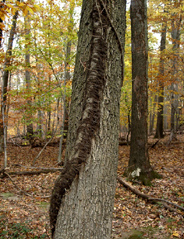 |
#2 Poison
ivy is a woody vine that thrives along much of the CERA Trail. Because
contact with poison ivy can cause dermatitis, it's important to
know wha t
it looks like and to avoid touching it. Poison ivy grows as a hairy
vine that climbs upward on tree trunks. It also grows as upright
woody stems from an underground runner. Between April and October,
poison ivy will have leaves
arranged in groups of three ("leaflets three, let it be").
It also has white berries in the autumn ("berries white, poisonous
sight"). Avoid touching any hairy vines or any leaves arranged
in groups of three. Dermatitis from poison ivy usually begins as
an itch that quickly becomes red and blistery. Wash any exposed
skin with soap and water after finishing this hike, and launder
your clothes promptly. On a more positive note, more than 60 species
of birds eat poison ivy berries, including northern flickers, mockingbirds,
and downy woodpeckers. t
it looks like and to avoid touching it. Poison ivy grows as a hairy
vine that climbs upward on tree trunks. It also grows as upright
woody stems from an underground runner. Between April and October,
poison ivy will have leaves
arranged in groups of three ("leaflets three, let it be").
It also has white berries in the autumn ("berries white, poisonous
sight"). Avoid touching any hairy vines or any leaves arranged
in groups of three. Dermatitis from poison ivy usually begins as
an itch that quickly becomes red and blistery. Wash any exposed
skin with soap and water after finishing this hike, and launder
your clothes promptly. On a more positive note, more than 60 species
of birds eat poison ivy berries, including northern flickers, mockingbirds,
and downy woodpeckers.
|
|











